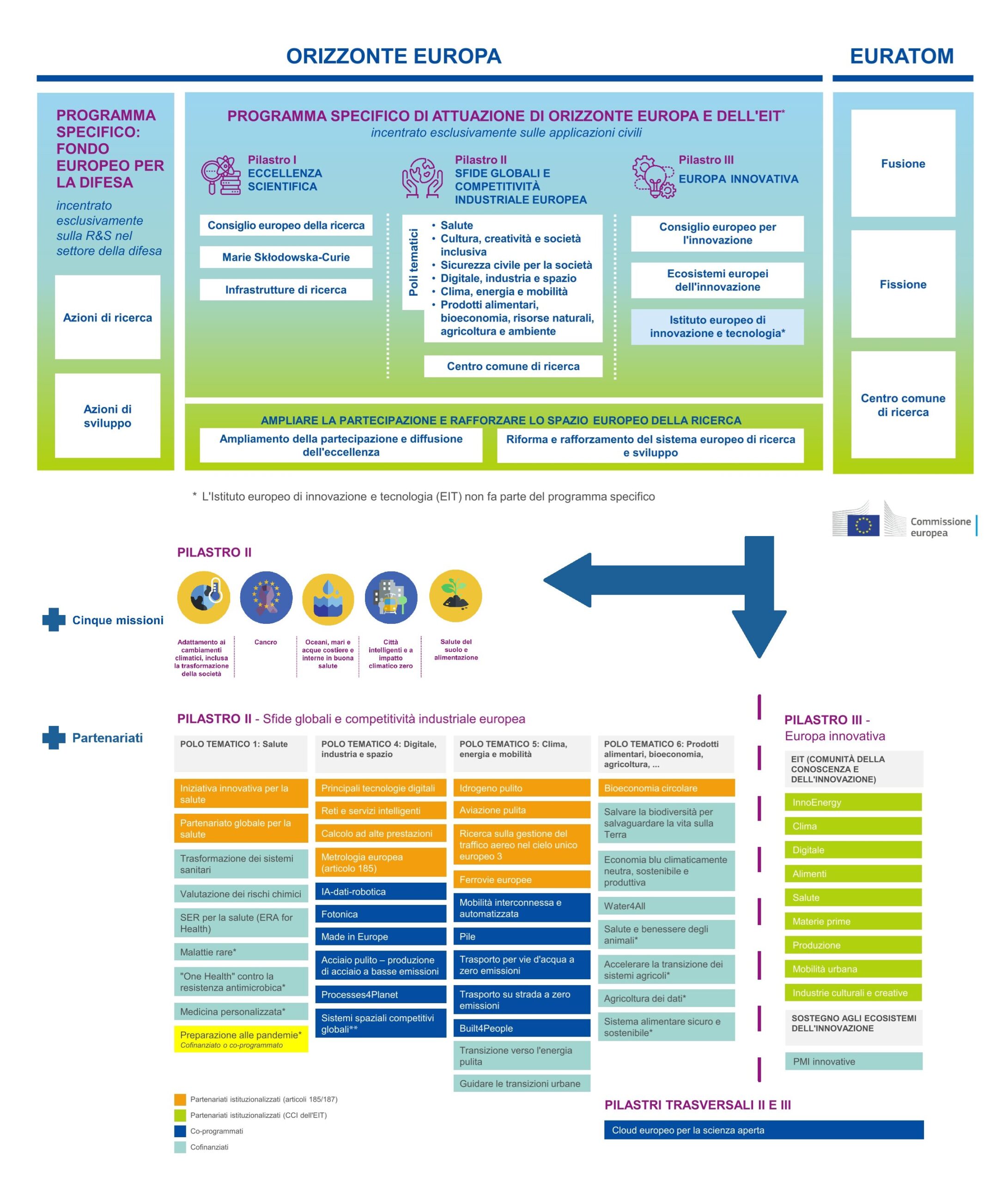Directions, tips and insights from some recently published analysis reports on the Horizon Europe program. Let’s analyze them together.
Horizon Europe: time to take stock
For Horizon Europe, the largest of the EU programs, dedicated to research and innovation, it is time for reflections and reviews. Indeed, in recent weeks, several reports have been published aimed at making an assessment of it, improving its action in the second part of the programming period (between the end of this year and 2027) and (why not) starting the reflection that will lead to the programs of the next seven years. The indications provided by these reports allow people to learn more about the opportunities offered by the Horizon Europe program and provide useful elements to improve the quality of their proposals. The Horizon Europe program evolves quickly, is highly articulated and produces a large number of calls in many thematic areas. For those who know little about it and want to understand briefly its structure and operation, we propose (in addition to the dedicated chapter on our Guide) a concise official presentation, from which we have drawn the following recapitulatory outline.The outline may be useful to orient oneself in the terminology used in this article (Pillars, Thematic Poles, Missions, Partnerships).
Horizon Europe, for a more resilient Europe: insights for your own projects
A report published in January (but presented in June in a special webinar) analyzes the Horizon Europe’s contribution to a more resilient Europe.. It covers the first 3 Thematic Poles under Pillar II (Health; Culture, Creativity and Inclusive Society; and Civil Security for Society), seven of the Partnerships pertaining to those Thematic Poles, and the Cancer Mission. The report highlights some aspects that are considered important, or that are intended to be given more attention within the program. The same aspects may represent added value in the development of one’s project proposals. We list the main ones below.
- Importance ofadaptation to new and emerging challenges: Covid-19 and mental health (health thematic pole), war in Ukraine (civil society mobilization and civil security thematic poles), climate-related natural disasters (civil security thematic pole);
- Importance of creating synergies between different themes: e.g., between health and civil society, between the different thematic hubs and the one dedicated to digital, between the different thematic hubs and the need to meet growing challenges in security and technological competitiveness;
- Importance ofexploitation of project results: in addition to academic purposes, in terms of dissemination to stakeholders and civil society as a whole, creation of stable, structuring and long-term partnerships, and entrepreneurial exploitation (including through tools such as Horizon Results Booster).
The study also points out that the program is somewhat “more accessible” than in the past, as the wide variety of components and themes has (at least in the components examined) reduced competition on individual calls for proposals. It quantifies the effort required toprepare a project at about 40 days of work for project leaders and about 20 for partners, and administrative management costs at about 8 percent of the project budget.
Horizon Europe for Green Transition: insights for your own projects
A second report, published in May, analyzes Horizon Europe’s Contribution to “Green Transition.” It covers all the program’s activities, which has a link to the Green Transition theme in all its components. It has a specific focus on Thematic Clusters 5 (Climate, Energy and Mobility) and 6 (Food, Bioeconomy, Natural Resources, Agriculture and Environment) and related Partnerships. This report also highlights some important aspects or to pay more attention to, which can be an added value in the development of one’s project proposals. Below are the main ones.
- Importance of design processes based on interaction between “top-down” and “bottom-up” approaches and between different but related strategic priorities (e.g. link between social needs and emerging issues in the area of green transition, and between these and research and innovation activity). Improving synergies between different actions is particularly important to compensate for the fragmentation of Horizon Europe into different Pillars, Thematic Poles, Partnerships, and Missions;
- Need to focus more on theinteraction between different technological and non-technologicalsolutions from innovative mixes of available and emerging technologies applicable to the nature and logic of green transition processes as such, on issues related to socio-cultural change (alignment of stakeholder action, governance, lifestyles and behavioral change) and structural and infrastructural transformations (definition and implementation of new paradigms, values, regulations, standards and norms);
- Importance of using more broadly and consciously the tools offered by Horizon Europe to create synergies and focus more on structural and socio-cultural changes, such as Partnerships (especially Co-funded Partnerships), the Innovation Fund and the Horizon Europe Missions. Some of these instruments are not yet sufficiently understood by civil society organizations and local authorities;
- Need to pay more attention to the technological aspects of innovation. For example: linking project outputs to demonstration, validation and patenting of developed technologies; overcoming potential “lock-in” dynamics (obstacle to the emergence of new, more effective technologies due to competitive advantage gained from existing technologies);
- Need to develop monitoring systems more accurate, particularly with regard to key-indicators of particular importance (e.g., measurement of the environmental, social and industrial impact of a new technology)-although these are in many cases difficult aspects and data to assess and acquire.
The report also confirms that the accessibility and procedures of the program are satisfactory for most beneficiaries, although not yet enough to encourage (as hoped) participation by a substantial number of small and medium-sized enterprises.
Horizon Europe for Digital and Industrial Transition: insights for your own projects
A third report, presented via webinar in June, although not yet available in text form, assesses the Horizon Europe’s Contribution to Digital and Industrial Transition.. We summarize some of its conclusions, which are equally suggestive in guiding approaches in their own research projects and innovations.
- Need fordeeper integration of research, innovation, and industry; impact orientation to address complex challenges; responsiveness and tools to identify and address emerging needs in rapidly evolving technology areas; to preside over strategic areas (such as quantum, space, advanced materials) and promote EU’s ability to produce new patents; while maintaining a balance with basic and pre-competitive R&I and“technology-neutral” approaches (useful to address complex challenges);
- Importance of “agile“ projects: in size, linkage to relevant policies, tools chosen, ability to integrate technology solutions in systemic and value chain terms (not just develop individual technologies). Importance of strengthening social acceptance of technology, incentives for lifestyle change, industry absorptive capacity, and cross-sectoral collaboration, including at the project level;
- Enhance Horizon Europe’s role as a “facilitator” to promote collaborations across countries and sectors. Improve connections between projects and use the tools offered by the program (such as Partnerships) to promote participation of industrial stakeholders, reduce risk, build trust, reduce fragmentation, and create critical mass. Promote strategic collaboration initiatives with global leaders (while maintaining an orientation to the strategic interest of the EU);
- Address remaining gaps in monitoring and evaluation, which are still sometimes limited or poorly consistent, including considering the use of structured and interoperable monitoring and data systems.
We also highlight a fourth report, also presented via webinar in June, and also not yet available in text form, which assesses the Horizon Europe’s Contribution to Scientific Excellence (Pillar I). Its conclusions broadly echo the findings of the other studies mentioned in this article.
Other insights, from an overall strategic assessment
A July study by the European Parliament offers a strategic assessment of various aspects of the Horizon Europe program: calls, funding, administrative aspects, strategic plan, barriers to participation and evaluation system. Again, some useful suggestions can be highlighted to guide one’s work on European projects in the field of research and innovation. A good project can, in its own small way, try to respond to some of the observations produced by the report.
- Despite the program’s growth (in terms of funding and participating organizations), the report calls out the need to ensure fairness and balance in the distribution of funding: among member states, among organizations (larger and lesser known), and among disciplines (more and less explored by the Horizon program). In particular, it is found that Horizon Europe’s emphasis on higher “levels of technological readiness” (i.e., those that are more applied and closer to commercial exploitation) can penalize early-stage research, which is crucial to achieving disruptive innovations;
- The study found a low awareness among practitioners of Horizon Europe’s strategic plan and its relevance to setting program priorities and calls. This confirms the importance of alignment between policies, strategies, programs and projects (which we discuss in this chapter);
- In general, operators point to a widespread lack of awareness regarding the program and available funding opportunities. The problems are particularly felt by small and medium-sized enterprises, for which the role of “compass platforms” and National Contact Points is crucial in bridging the gap. We hope that initiatives such as this Guide and this article can make a contribution;
- The study confirms the perceived fragmented nature of the Horizon Europe program. As highlighted above, this fragmented nature makes it difficult to ensure strategic alignment between different initiatives and to create initiatives that bring together research communities with an interdisciplinary and long-term vision.
European Partnerships: an opportunity to be explored further
An April report analyzes theEffectiveness of European Partnerships., one of the instruments of Horizon Europe. It clarifies their underlying rationale, objectives, expectations and structure. It provides a detailed assessment of their operation and specific fact sheets on the various Partnerships and the contribution of different member states. The 43 European Partnerships analyzed by the report (a total of 59 will be developed under the program) are aimed at improving coordination and collaboration with member states on strategic issues, aligning Horizon Europe’s action more closely with societal needs and policy priorities, maximizing resources to increase the scale of interventions, promoting coherence of actions, and broadening the range of actors involved. Partnerships have about 64 billion euros, of which about 25 billion are made available by the Horizon program and about 39 made available by other partners. They represent 26 percent of Horizon Europe’s total budget and a substantial part (40 percent) of Pillar II (Global Challenges and European Industrial Competitiveness). They cover various thematic areas: climate change, environmental degradation, hyperconnectivity, resource scarcity and health, and (to a lesser extent) social and human issues such as security, demographic change, governance, education and skills. Knowing more about European Partnerships can pave the way for new project opportunities.
Horizon Europe: opportunities for small and medium-sized enterprises
Another report in July analyzes the Participation of small and medium-sized enterprises in the Horizon program and the factors influencing it. As mentioned earlier, SME participation in the program is an important factor: SMEs form the backbone of the industrial system, especially in countries like Italy, and are developers and disseminators of technologies and innovations. On the other hand, their participation is hampered by the complexity of the program and the choice (especially in some of the more specialized components of the program) to focus on a small number of innovation and research “excellences.” Horizon Europe is a highly competitive program, in which only a minority of high-quality applications can be selected for funding, and which in most cases does not provide preferential conditions for SMEs (which mostly participate as partners of larger organizations). However, the report highlights encouraging and growing data compared to the previous program (Horizon 2020): SMEs account for 34 percent of Horizon Europe participants (about half of whom are in their first experience on the program), have a success rate of about 20 percent, and receive more than 20 percent of the program’s funding. SME equity investments offered by the European Innovation Council’s dedicated fund and Horizon actions managed at the decentralized level, such as those carried out under theKnowledge and Innovation Communities (KICs) of theEuropean Institute of Innovation and Technology (EIT), play an important role in this success. These are the tools most typically dedicated to SMEs under Horizon Europe. An opportunity for SMEs to explore is also that of the Seal of Excellence, particularly in cases where this is adopted as a preferred criterion by other funding bodies. However, SMEs also participate in collaborative projects, especially under Pillar II (Global Challenges and European Industrial Competitiveness) and as partners.
Global assessments of European research and innovation
In conclusion, we point to the recent publication of important data and reports on the state of European research and innovation, as a whole.
European innovation scoreboard 2024 (July 2024)
Report | Executive summary | Website | Country profile Italy
Science, Research and Innovation performance of the EU 2024 report (June 2024)
Report | Executive summary | Website Taken together, these reports provide an additional source of knowledge, data and insights to better guide one’s research and innovation projects.See you soon with new updates on European projects.





